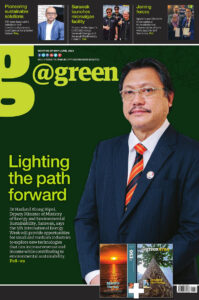The decarbonisation of the power sector is crucial in realising Malaysia’s goal of becoming a carbon-neutral nation by 2050. As the national utility giant, Tenaga Nasional Berhad (TNB) consistently ups its effort to ensure sustainability in the power sector. TNB places the most critical aspect of its sustainability agenda on supporting global efforts in climate change mitigation.
TNB Head of Corporate Ventures, Strategy & Ventures Division, Zaman Ahmad, said the company started its sustainability journey in 2016 when it introduced the Reimagining TNB strategic plan. Then, the energy player was obvious in its direction to diversify energy sources and reduce carbon emissions.

“In 2019, we had another refresh, and the pandemic hit. During the pandemic, the world accelerated immensely to say, ‘Hey, we need to decarbonise, right?’ and that’s why in August 2021, we announced our Sustainability Pathway 2050 to the world,” shared Zaman.
“We have two clear targets. There’s a half-time target: by 2035, we’re going to reduce our emissions by 35 per cent and coal capacity by 50 per cent. And at the end of the game in 2050, we intend to be
net zero and coal-free.
“The question is, how will we be able to execute it? Suppose we do achieve what we’re saying effectively. In that case, our power generation will be less carbon and still be able to meet the three challenges that we always face: electricity affordability, sustainability and security.
“Moving forward until the year 2050, we must keep those three things in mind, the energy trilemma. By integrating this net zero target into our plan, the one thing that we want to do is to deliver the message to the rakyat that everybody has a role to play. This is just not a power generation or utility problem. It is Malaysia’s problem. It is Malaysia’s challenge to solve, and we got to do it all together.”
Emphasising technology and partnerships
According to Zaman, TNB currently has coal and gas plants within its entire fleet of power generation, where it has committed to the power purchase agreements beyond 2040.
“Within these plants, we’re looking at new and green technologies that are just emerging and eventually will become viable. So, we have coal plants and gas plants. For coal plants, we would like to be able to, hopefully, co-fire them with green ammonia. And that effectively reduces the emissions immediately within our coal plants. When it comes to gas, we’re looking at green hydrogen because we can co-fire it. We’re looking at these two solutions for Malaysia,” said Zaman during the International Sustainable Energy Summit (ISES) 2022.
He elaborated that renewable energy was one of the key ingredients behind green ammonia and green hydrogen. TNB, as a strong player in the renewable energy arena, actively embarks on business cases and joint feasibility studies.
“We just signed a memorandum of understanding (MoU) with PETRONAS. Two largest government-linked companies (GLCs). It is time we come together for the nation. It is about working together— how can we produce green hydrogen, potentially green ammonia, reduce our emissions and meet our targets? The key message is we can’t do this alone. We have to work with partners. We’re looking for good partners, whether on the technology side or the business side.”
TNB’s sustainability pillars
Touching on TNB’s sustainability pillars, Zaman highlighted that the critical thing they had to think about was technology. There are many available pathways; some technologies might work while others might not. The company should make the best decision and try the available options.
“Another part of the sustainability pillars we must consider is capability. Within this new repowering responsibility towards the net zero future in Malaysia, we’ll need new skills. We reckon that most of the jobs by 2050 don’t exist today. It’s going to create new opportunities. So the words reskilling and upskilling come along, and we will be focusing on the people part.”
On the last part of the pillars, he stated that the focus would be on addressing the energy trilemma.








